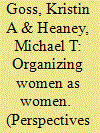|
|
|
Sort Order |
|
|
|
Items / Page
|
|
|
|
|
|
|
| Srl | Item |
| 1 |
ID:
096276


|
|
|
|
|
| Publication |
2010.
|
| Summary/Abstract |
The Million Mom March (favoring gun control) and Code Pink: Women for Peace (focusing on foreign policy, especially the war in Iraq) are organizations that have mobilized women as women in an era when other women's groups struggled to maintain critical mass and turned away from non-gender-specific public issues. This article addresses how these organizations fostered collective consciousness among women, a large and diverse group, while confronting the echoes of backlash against previous mobilization efforts by women. We argue that the March and Code Pink achieved mobilization success by creating hybrid organizations that blended elements of three major collective action frames: maternalism, egalitarianism, and feminine expression. These innovative organizations invented hybrid forms that cut across movements, constituencies, and political institutions. Using surveys, interviews, and content analysis of organizational documents, this article explains how the March and Code Pink met the contemporary challenges facing women's collective action in similar yet distinct ways. It highlights the role of feminine expression and concerns about the intersectional marginalization of women in resolving the historic tensions between maternalism and egalitarianism. It demonstrates hybridity as a useful analytical lens to understand gendered organizing and other forms of grassroots collective action.
|
|
|
|
|
|
|
|
|
|
|
|
|
|
|
|
| 2 |
ID:
176182


|
|
|
|
|
| Summary/Abstract |
Recognizing the increasing ubiquity of protest in the United States, this article considers why protest has become so central to American politics. It argues that three factors contribute substantially to this situation: institutional illegitimacy, political polarization, and decentralization of communications media. Institutional illegitimacy means that Americans are less likely to trust the prevailing system of government, such as selecting the president through the Electoral College, making them more likely to believe that protest is necessary to have their voices heard. Political polarization coincides with having elected officials on the extremes of the political spectrum, rather than toward the moderate center. Citizens are thus more likely to be dissatisfied with elected officials and to turn out to protest them. Decentralization of communications media, especially social media (e.g. Twitter, Facebook, Instagram), allows activists to communicate with one another more readily and, therefore, to organize protests quickly and with few financial resources. These conditions are unlikely to change in the near future outside of a major partisan realignment. Recent protests organized by Black Lives Matter and related groups, in response to the deaths of George Floyd and many other African Americans, illustrate the contemporary nature of activism, social movements, and protest in the United States.
|
|
|
|
|
|
|
|
|
|
|
|
|
|
|
|
| 3 |
ID:
190274


|
|
|
|
|
| Summary/Abstract |
Within the context of a social movement, a niche is a set of its supporters’ characteristics that define the movement’s location in a multidimensional space. Niches may clearly separate movements from one another or niches may overlap. This article examines the realization of an activist niche by Black Lives Matter (BLM), which has become one of the most prominent movements of the early twenty-first century. It draws on surveys of 3,860 activists conducted in Washington, DC, in 2017 and 2018, and 393 surveys of activists participating in the March for Racial Justice in five cities in 2017. The results show that BLM activists formed a niche along five dimensions. First, BLM activists have a greater-than-average commitment to intersectional activism than do comparable activists in other movements. Second, they use social media more regularly for political purposes than do their peers working on other causes, which helps the movement operate in a decentralized fashion. Third, they are less satisfied with how democracy is practiced in the United States. Fourth, they are more likely to acknowledge justifications for using violence for political purposes. Fifth, they report having experienced high levels of anger in conjunction with politics.
|
|
|
|
|
|
|
|
|
|
|
|
|
|
|
|
|
|
|
|
|